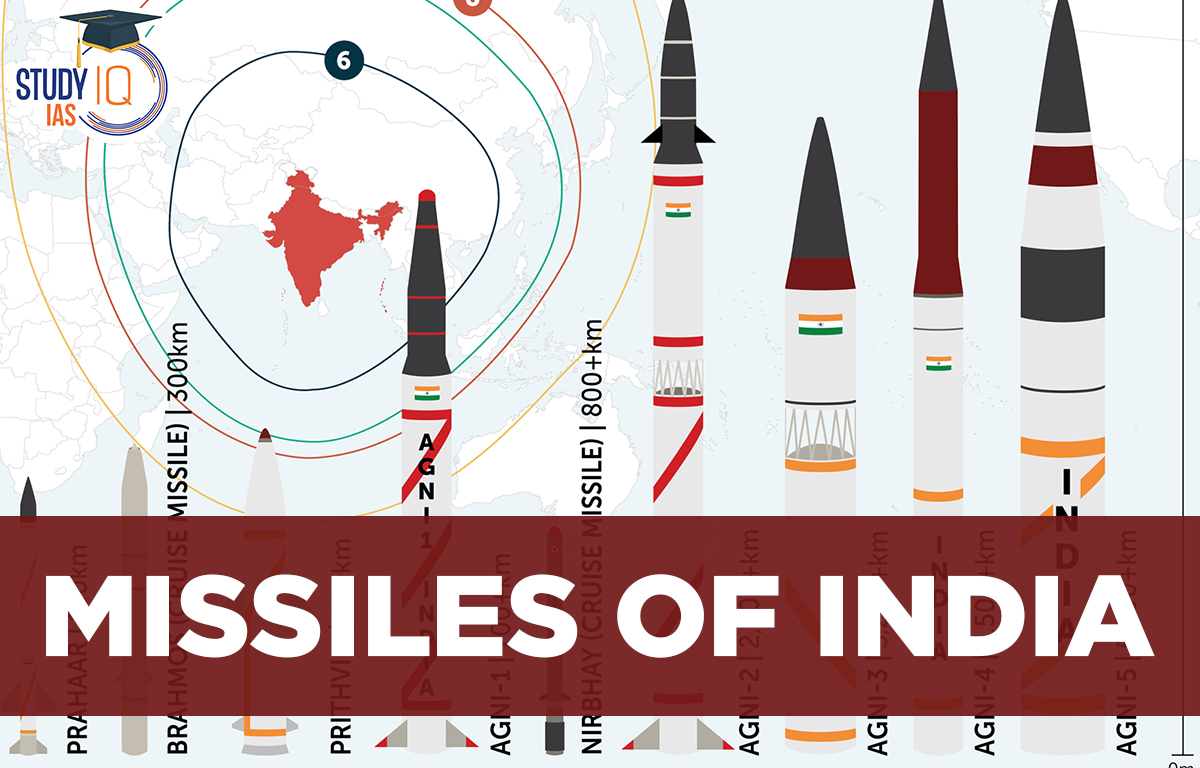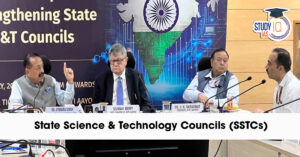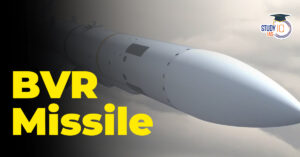India’s missile program is a reflection of the country’s increasing technological and strategic prowess. Under the auspices of the Defence Research and Development Organisation (DRDO), the Missiles of India inventory consists of a wide variety of ballistic, cruise, and anti-aircraft missiles intended for a variety of defence and deterrence purposes.
From the short-range Prithvi to the intercontinental Agni-V, and precision-guided systems like BrahMos, India has made impressive contributions in beefing up its defence infrastructure and projecting itself as a prominent actor in world missile technology. Check here the List of Missiles of India and their Types in detail.
Missiles of India
A missile is also referred to as a guided missile in military jargon. A guided missile is a self-propelled flying weapon that is typically driven by a fighter jet engine or rocket motor. An object that can be launched, shot, or pushed toward a target is referred to as a missile in everyday speech. The Missiles of India are used for a variety of defence-related reasons. Fundamentally, its arsenal of ballistic missiles serves as a platform for the delivery of nuclear weapons to both China and Pakistan.
India’s development of longer-range ballistic missiles and its diversification of its delivery vehicles beyond mobile land-based missiles are both driven by military requirements. In the age of modernity, India is working with Russia to develop cruise missiles and ship-launched ballistic missiles in order to become a strong country. In most competitive tests, the defence is a significant and engaging component that is combined with the General Knowledge section.
Types of Missiles of India
India has a multifaceted and rapidly expanding arsenal of missiles, distinguished by factors such as the type of launch platform, range, and target. The following is a list of major categories of missiles of India:
| Type |
Details |
| Based on Launch Platform |
- Surface-to-Surface Missiles (SSM)
- Surface-to-Air Missiles (SAM)
- Air-to-Air Missiles (AAM)
- Air-to-Surface Missiles (ASM)
- Sea-to-Sea Missiles
- Sea-to-Surface Missiles
- Submarine-Launched Ballistic Missiles (SLBM)
- Anti-Tank Guided Missiles (ATGM)
|
| Based on Trajectory |
- Ballistic Missiles
- Cruise Missiles
|
| Based on Range |
- Short-Range Ballistic Missiles (SRBM)
- Medium-Range Ballistic Missiles (MRBM)
- Intermediate-Range Ballistic Missiles (IRBM)
- Intercontinental Ballistic Missiles (ICBM)
- Tactical Missiles
|
| Based on Speed |
- Subsonic Missiles
- Supersonic Missiles
- Hypersonic Missiles
|
| Based on the Guidance System |
- Different guidance systems are used, such as inertial navigation, active radar homing, infrared homing, laser guidance, and GPS/NavIC.
|
| Based on Warhead |
- Missiles may be equipped with conventional (high explosives) or strategic (nuclear) warheads, based on their intended use.
|
List of Missiles in India
Check here the complete List of Missiles in India, categorised by their types:
Air-to-Air missiles
| Name of the Missile |
Type |
Range |
| MICA |
Short to medium-range |
500 m to 80 km |
| Astra |
Beyond Visual Range |
80-110 km |
| Novator K-100 |
Medium-range air-to-air missile |
300–400 km |
Surface-To-Air Missiles
| Name of the Missile |
Type |
Range |
| Trishul |
Short-range surface-to-air missile |
9 km |
| Akash Missile |
Medium-range surface-to-air missile |
30-35km |
| Barak 8 |
Long-Range Surface-to-Air Missile (developed with Israel) |
100 km |
| Quick Reaction Surface-to-Air Missile (QRSAM) |
Short-range |
|
| VL-SRSAM |
Vertical Launch Short Range Surface-to-Air Missile |
|
| SAMAR Air Defence System |
Short/Medium-Range Air Defence System |
|
| Prithvi Air Defence (PAD) |
Exo-atmospheric interceptor |
Altitude- 80km (high altitude) |
| Advanced Air Defence (AAD)/Ashwin |
Endo-atmospheric interceptor |
Altitude- 120km (lower altitude) |
| Prithvi Defence Vehicle (PDV) |
Exo-atmospheric interceptor |
Altitude- 30km |
Surface-to-Surface Missiles (Ballistic Missiles)
| Name of the Missile |
Type |
Range |
| Agni Series |
| Agni-I |
Short-range ballistic missile |
700-1250 km |
| Agni-II |
Medium-range ballistic missile |
2,000–3,000 km |
| Agni-III |
Intermediate-range ballistic missile |
3,500 km – 5,000 km |
| Agni-IV |
Intermediate-range ballistic missile |
3,000 – 4,000 km |
| Agni-V |
Intercontinental ballistic missile |
5000 – 8000 Km |
| Agni-P (Agni Prime) |
Medium-range ballistic missile |
1,000-2,000 km |
| Agni-VI |
Intercontinental ballistic missile |
under development, potential range up to 16,000 km |
| Prithvi Series |
| Prithvi I |
Short-Range Ballistic Missile |
150 km (being withdrawn) |
| Prithvi II |
Short-Range Ballistic Missile |
350 km (being withdrawn) |
| Prithvi-III |
Short-Range Ballistic Missile |
350-600 km (in service) |
| Other Missiles |
| Dhanush |
Short-Range Ballistic Missile |
350 – 600 km |
| Shaurya |
Medium-Range Ballistic Missile |
750 to 1,900 km |
| Prahaar |
Short-Range Ballistic Missile |
150 km |
| Pralay |
Short-range surface-to-surface tactical ballistic missile |
150-500 km |
Cruise Missiles
| Name of the Missile |
Type |
Range |
| BrahMos |
Supersonic cruise missile |
290-500 km |
| BrahMos II |
Hypersonic cruise missile |
300km |
| Nirbhay |
Subsonic cruise missile |
1,000 -1500 km |
| Indigenous Technology Cruise Missile (ITCM) |
Under development |
|
Submarine Launched Ballistic Missiles (SLBM)
| Name of the Missile |
Type |
Range |
| Ashwin |
Ballistic Missile |
150-200km |
| Sagarika (K-15) |
Short-range Ballistic Missile |
700 – 1900 Km |
| K-4 |
Medium-range Ballistic Missile |
3,500–5,000 km |
| K-5 |
Intermediate-range Ballistic Missile |
5000-6,000 km |
Anti-Tank Guided Missile (ATGM)
| Name of the Missile |
Type |
Range |
| Amogha |
Short-range Anti-Tank Guided Missile |
2.8 km |
| Nag |
Fire-and-forget Anti-Tank Guided Missile |
4-10 km |
| Helina/Dhruvastra |
Helicopter-launched Nag |
7-10 km |
| Man-Portable Anti-Tank Guided Missile (MPATGM) |
Short-range |
|
Missiles of India: Important Facts for UPSC
- The 1983 launch of the Integrated Guided Missile Development Program (IGMDP).
- The goal of this programme was to build the Trishul, Akash, Nag, Prithvi, and Agni-I missile systems in the nation.
- The intermediate-range surface-to-surface missiles mentioned above.
- The “Missile Woman” of India is Tessy Thomas, an Indian scientist who serves as the Director General of Aeronautical Systems and the former Project Director for the Agni-IV missile in the Defence Research and Development Organisation (DRDO).
- Prithvi was the nation’s first surface-to-surface missile with a single stage and liquid fuel.
Sharing is caring!


 State Science and Technology Councils (S...
State Science and Technology Councils (S...
 Astronomers Discover Third Interstellar ...
Astronomers Discover Third Interstellar ...
 DRDO and Air Force Successfully Test Ind...
DRDO and Air Force Successfully Test Ind...





















